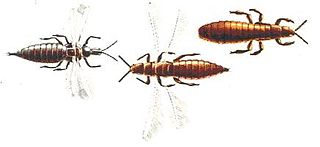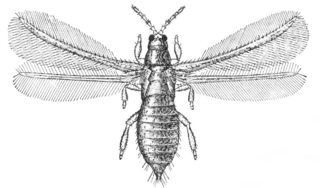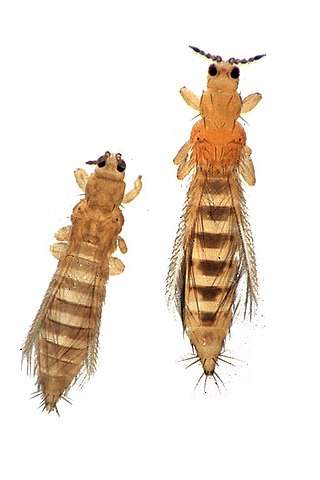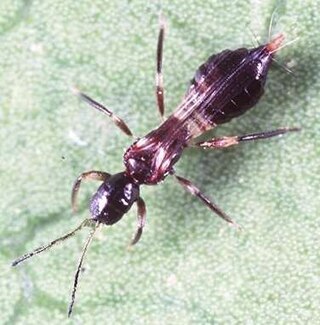
Thrips are minute, slender insects with fringed wings and unique asymmetrical mouthparts. Entomologists have described approximately 7,700 species. They fly only weakly and their feathery wings are unsuitable for conventional flight; instead, thrips exploit an unusual mechanism, clap and fling, to create lift using an unsteady circulation pattern with transient vortices near the wings.

Velvet spiders are a small group of spiders almost entirely limited to the Old World, with the exception of one species known from Brazil. In Europe, some are commonly called the ladybird spiders.

The Thripidae are the most speciose family of thrips, with over 290 genera representing just over two thousand species. They can be distinguished from other thrips by a saw-like ovipositor curving downwards, narrow wings with two veins, and antennae of six to ten antennomeres with stiletto-like forked sense cones on antennal segments III and IV.

Paraneoptera or Acercaria is a superorder of insects which includes lice, thrips, and hemipterans, the true bugs. It also includes the extinct order Permopsocida, known from fossils dating from the Early Permian to the mid-Cretaceous.

The Thripinae are a subfamily of thrips, insects of the order Thysanoptera. The Thripinae belong to the common thrips family Thripidae and include around 1,400 species in 150 genera. A 2012 molecular phylogeny found that the Thripinae was paraphyletic; further work will be needed to clarify the relationships within the group.

Haplothrips is a genus of thrips in the family Phlaeothripidae. It is found worldwide and contains about 240 extant species.

Terebrantia is a suborder of thrips. Order Thysanoptera includes 5,500 species classified into two suborders distinguished by the ovipositor. Terebrantia have a well-developed conical ovipositor, while the Tubulifera do not. It contains 13 families, five of which are only known from fossils. Members of Terebrantia mainly feed on plants. All have two larval instars followed by two pupal instars.
Elaphrothrips is a genus of tube-tailed thrips in the family Phlaeothripidae. There are at least 40 described species in Elaphrothrips.
Gynaikothrips ficorum, the Cuban laurel thrips, is a species of tube-tailed thrip in the family Phlaeothripidae. It is found in Africa, North America, and Europe. It is widespread around the world because of its host, Ficus.
Gynaikothrips is a genus of tube-tailed thrips in the family Phlaeothripidae. There are more than 30 described species in Gynaikothrips.
Neurothrips is a genus of tube-tailed thrips in the family Phlaeothripidae. There are about six described species in Neurothrips.
Haplothrips leucanthemi, known generally as the clover thrips or red clover thrips, is a species of tube-tailed thrip in the family Phlaeothripidae. It is found in North America, South America, and Europe.
Ablemothrips is a genus of thrips in the family Phlaeothripidae. It occurs in Asia, with two species recorded from Thailand and one species occurring in India, southern Japan, the Philippines, and Taiwan.
Adelphothrips is a genus of thrips in the family Phlaeothripidae. Species are known to occur on Java, Fiji and in the Philippines.
Agynaikothrips is a genus of thrips in the family Phlaeothripidae. It occurs in Asia, with one species known from Japan and the other from Taiwan.
Idolothrips is a genus of thrips in the family Phlaeothripidae.
Koptothrips is a genus of thrips in the family Phlaeothripidae, first described by Richard Siddoway Bagnall in 1929.
Malesiathrips is a genus of thrips in the family Phlaeothripidae. Species of the genus are found in Malaysia, Guam, Solomon Islands and northern Queensland, Australia.
Plectrothrips is a genus of thrips in the family Phlaeothripidae, first described by Joseph Douglas Hood in 1908.
Laurence Alfred Mound is an entomologist, who works mostly on the biology and systematics of Thysanoptera (thrips), an area in which he is considered a world authority.







